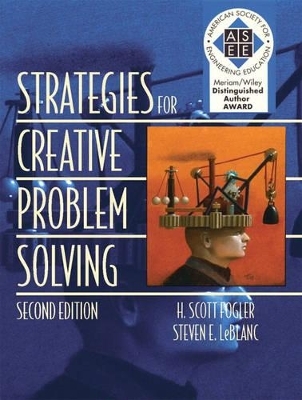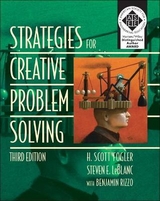
Strategies for Creative Problem Solving
Prentice Hall
978-0-13-008279-4 (ISBN)
- Titel erscheint in neuer Auflage
- Artikel merken
Strategies for Creative Problem Solving, Second Edition, will help you sharpen your “street smarts” and leverage your creative skills to find better solutions for virtually any technical problem. Drawing on advanced, National Science Foundation-funded research, it introduces a start-to-finish problem-solving framework that integrates proven strategies from today’s most effective technical organizations. Using its hands-on techniques and exercises, you’ll learn how to gather data, systematically identify problems, generate superior alternatives, choose and implement the best solution, evaluate what you learn, and use that knowledge to create even better outcomes.
The first edition of Strategies for Creative Problem Solving won the prestigious American Society for Engineering Education Meriam/Wiley Distinguished Author Award. This new edition has been systematically updated and revised, offering even greater value to every engineer, technical practitioner, and student. Among its many improvements:
Dozens of new examples, plus two detailed real-world case studies
Better, more coherent organization, reflecting feedback from thousands of students and professionals
New coverage of team-based problem solving, including conflict resolution
More coverage of critical thinking, including the use of the Socratic method
An introduction to the powerful TRIZ technique for resolving contradictions
Proven troubleshooting algorithms for identifying root causes of equipment and process problems
All-New CD-ROM and Web Site
The CD-ROM and Web site contain numerous enrichment opportunities for both students and instructors including
Interactive Computer Modules: Seven simulations, which are linked to the book’s content and are designed to deepen your expertise with every stage of the problem-solving process.
Summary Notes: Chapter-specific material that highlights important points in each chapter–excellent for classroom presentations and concept review.
Learning Resources: Thoughts on problem solving; closed-ended and open-ended problem-solving heuristics.
Professional Reference Shelf: Additional examples and problem-solving material.
Additional Study Materials: Course syllabi and Web links to related material.
H. Scott Fogler is the Arthur F. Thurnau Professor, Vennema Professor of Chemical Engineering at the University of Michigan. His research interests include flow and reaction in porous media, fused chemical relations, gellation kinetics, and chemical reaction engineering problems in the petroleum industry. He has graduated 37 Ph.D. students and has more than 200 refereed publications in these areas. Fogler is the AIChE 2008 President-elect. He has chaired ASEE’s Chemical Engineering Division, served as director of the American Institute of Chemical Engineers, earned the Warren K. Lewis Award from AIChE for contributions to chemical engineering education, and received the Chemical Manufacturers Association’s National Catalyst Award. He is the author of the classic Elements of Chemical Reaction Engineering, Fourth Edition (Prentice Hall, 2006). Steven E. LeBlanc is Senior Associate Dean for Academic Affairs and Professor of Chemical Engineering at the University of Toledo. He chaired the Chemical and Environmental Engineering Department for ten years, chaired the ASEE Chemical Engineering Education Division, and co-chaired the 2007 ASEE Chemical Engineering Summer School for Faculty.
Preface xi
Chapter 1: Problem-Solving Strategies: Why Bother? 1
What’s the Real Problem? 1
Correct Problem Definition/Wrong Solution 6
A Heuristic for Successful Problem Solving 9
Summary 11
CD-ROM Material 11
References 13
Exercises 14
Further Reading 14
Chapter 2: The Characteristics, Attitudes, and Environment Necessary for Effective Problem Solving 15
Getting in the Right Frame of Mind 15
Having a Vision 23
Working Together in Teams 25
Conflict Resolution 31
Team Decisions 33
Summary 34
CD-ROM Material 35
References 35
Exercises 36
Further Reading 39
Chapter 3: Gathering Information on the Problem 41
The First Four Steps 41
Summary 49
CD-ROM Material 49
References 49
Exercises 49
Chapter 4: Problem Definition 51
Defining the Real Problem: Four Techniques 51
Technique 1: Finding Out Where the Problem Came From 52
Technique 2: Using the Present State/Desired State and the Duncker Diagram to Define the Real Problem 58
Technique 3: Using the Statement—Restatement Technique 63
Technique 4: Kepner—Tregoe Problem Analysis 68
Which Technique to Choose? 72
Determine Whether the Problem Should Be Solved 74
Brainstorm Potential Causes and Solution Alternatives 75
Summary 76
CD-ROM Material 76
References 78
Exercises 78
Further Reading 88
Appendix: Questions for a Socratic Dialog 89
Chapter 5: Breaking Down the Barriers to Generating Ideas 93
Recognizing Mental Blocks 94
Blockbusting 99
Improving Your Creative Abilities 100
Risk Taking 104
Summary 110
CD-ROM Material 110
References 111
Exercises 111
Further Reading 114
Chapter 6: Generating Solutions 115
Brainstorming 115
Free Association 116
Vertical Thinking 118
Lateral Thinking 120
Futuring 122
Organizing Brainstorming Ideas: The Fishbone Diagram 124
Brainwriting 126
Analogy and Cross-Fertilization 127
Incubating Ideas 130
TRIZ 131
Summary 138
CD-ROM Material 138
References 140
Exercises 140
Further Reading 143
Chapter 7: Deciding the Course of Action 145
K.T. Situation Appraisal 146
K.T. Problem Analysis 151
K.T. Decision Analysis 151
Adverse Consequences of the Alternative Solutions 155
K.T. Potential Problem Analysis 163
Summary 168
CD-ROM Material 169
References 170
Exercises 170
Further Reading 178
Chapter 8: Implementing the Solution 179
Approval 179
Planning 180
Carry Through 185
Follow Up 187
Experimental Projects 187
Summary 194
CD-ROM Material 195
References 195
Exercises 196
Further Reading 198
Chapter 9: Evaluation 199
General Guidelines 199
Ethical Considerations 203
Safety Considerations 209
Summary 210
CD-ROM Material 210
References 211
Exercises 211
Further Reading 219
Chapter 10: Troubleshooting 221
Some General Guidelines 221
Early Morning Shivers: An Example of Troubleshooting 226
Technical Troubleshooting Exercise 230
Interactive Computing Module on Troubleshooting 237
Troubleshooting Laboratory Equipment 239
Summary 240
CD-ROM Material 240
References 240
Exercises 241
Chapter 11: Putting It All Together 245
Case Study 1: Generating Sustainable Power for an
Case Study 2: Problems at the Bakery Café 256
Summary 270
CD-ROM Material 271
Instructor’s Manual 271
References 271
Exercises 271
Appendix 1: McMaster’s Five-Point Strategy 273
Appendix 2: Plotting Data 275
Index 293
About the Authors 301
| Erscheint lt. Verlag | 27.9.2007 |
|---|---|
| Verlagsort | Upper Saddle River |
| Sprache | englisch |
| Maße | 178 x 234 mm |
| Gewicht | 528 g |
| Themenwelt | Wirtschaft ► Betriebswirtschaft / Management ► Unternehmensführung / Management |
| ISBN-10 | 0-13-008279-1 / 0130082791 |
| ISBN-13 | 978-0-13-008279-4 / 9780130082794 |
| Zustand | Neuware |
| Haben Sie eine Frage zum Produkt? |
aus dem Bereich


![International Economics plus Pearson MyLab Economics with Pearson eText [Global Edition] - James Gerber](/media/103476970)
